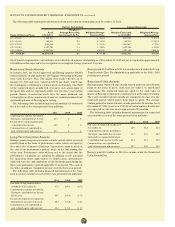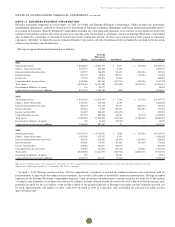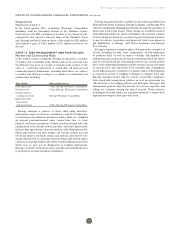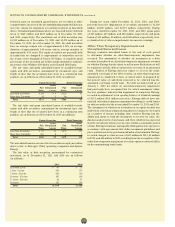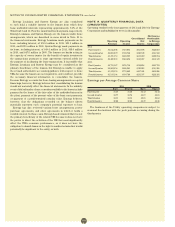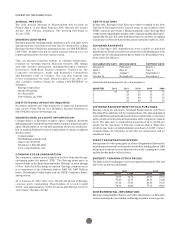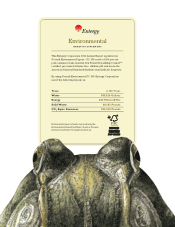Entergy 2011 Annual Report Download - page 111
Download and view the complete annual report
Please find page 111 of the 2011 Entergy annual report below. You can navigate through the pages in the report by either clicking on the pages listed below, or by using the keyword search tool below to find specific information within the annual report.
Entergy Corporation and Subsidiaries 2011
NOTES TO CONSOLIDATED FINANCIAL STATEMENTS continued
NOTE 18. VARIABLE INTEREST ENTITIES
Under applicable authoritative accounting guidance, a variable
interest entity (VIE) is an entity that conducts a business or holds
property that possesses any of the following characteristics: an
insufficient amount of equity at risk to finance its activities, equity
owners who do not have the power to direct the significant activities
of the entity (or have voting rights that are disproportionate to their
ownership interest), or where equity holders do not receive expected
losses or returns. An entity may have an interest in a VIE through
ownership or other contractual rights or obligations, and is required
to consolidate a VIE if it is the VIE’s primary beneficiary.
The FASB issued authoritative accounting guidance that became
effective in the first quarter 2010 that revised the manner in which
entities evaluate whether consolidation is required for VIEs. Under
the revised guidance, the primary beneficiary of a VIE is the entity
that has the power to direct the activities of the VIE that most
significantly affect the VIE’s economic performance, and has the
obligation to absorb losses or has the right to residual returns that
would potentially be significant to the entity. In conjunction with
the adoption of the new guidance, Entergy updated reviews of its
contracts and arrangements to determine whether Entergy is the
primary beneficiary of a VIE based on the revisions to the previous
consolidation model and other provisions of this standard. Based
on this review Entergy determined that Entergy Arkansas, Entergy
Gulf States Louisiana, Entergy Louisiana, and System Energy should
consolidate the respective companies from which they lease nuclear
fuel, usually in a sale and leaseback transaction. This determination
is because Entergy directs the nuclear fuel companies with respect
to nuclear fuel purchases, assists the nuclear fuel companies in
obtaining financing, and, if financing cannot be arranged, the lessee
(Entergy Arkansas, Entergy Gulf States Louisiana, Entergy Louisiana,
or System Energy) is responsible to repurchase nuclear fuel to allow
the nuclear fuel company (the VIE) to meet its obligations. Under
the previous guidance, the determination of the primary beneficiary
of a VIE was based on ownership interests and the risks and rewards
in the entity attributable to the variable interest holders. Therefore,
the Entergy companies did not previously consolidate the nuclear
fuel companies. Because Entergy has historically accounted for the
leases with the nuclear fuel companies as capital lease obligations,
the effect of consolidating the nuclear fuel companies did not
materially affect Entergy’s financial statements. During the term
of the arrangements, none of the Entergy operating companies
have been required to provide financial support apart from their
scheduled lease payments. See Note 4 to the financial statements for
details of the nuclear fuel companies’ credit facility and commercial
paper borrowings and long-term debt that are reported by Entergy,
Entergy Arkansas, Entergy Gulf States Louisiana, Entergy Louisiana,
and System Energy. These amounts also represent Entergy’s and
the respective Registrant Subsidiary’s maximum exposure to
losses associated with their respective interests in the nuclear
fuel companies.
Entergy Texas determined that Entergy Gulf States Reconstruction
Funding I, LLC, and Entergy Texas Restoration Funding, LLC,
companies wholly-owned and consolidated by Entergy Texas, are
variable interest entities and that Entergy Texas is the primary
beneficiary. In June 2007, Entergy Gulf States Reconstruction
Funding issued senior secured transition bonds (securitization
bonds) to finance Entergy Texas’s Hurricane Rita reconstruction
costs. In November 2009, Entergy Texas Restoration Funding issued
senior secured transition bonds (securitization bonds) to finance
Entergy Texas’s Hurricane Ike and Hurricane Gustav restoration
costs. With the proceeds, the variable interest entities purchased
from Entergy Texas the transition property, which is the right
to recover from customers through a transition charge amounts
sufficient to service the securitization bonds. The transition property
is reflected as a regulatory asset on the consolidated Entergy Texas
balance sheet. The creditors of Entergy Texas do not have recourse
to the assets or revenues of the variable interest entities, including
the transition property, and the creditors of the variable interest
entities do not have recourse to the assets or revenues of Entergy
Texas. Entergy Texas has no payment obligations to the variable
interest entities except to remit transition charge collections. See
Note 5 to the financial statements for additional details regarding the
securitization bonds.
Entergy Arkansas Restoration Funding, LLC, a company wholly-
owned and consolidated by Entergy Arkansas, is a variable interest
entity and Entergy Arkansas is the primary beneficiary. In August
2010, Entergy Arkansas Restoration Funding issued storm cost
recovery bonds to finance Entergy Arkansas’s January 2009 ice
storm damage restoration costs. With the proceeds, Entergy
Arkansas Restoration Funding purchased from Entergy Arkansas
the storm recovery property, which is the right to recover from
customers through a storm recovery charge amounts sufficient to
service the securitization bonds. The storm recovery property is
reflected as a regulatory asset on the consolidated Entergy Arkansas
balance sheet. The creditors of Entergy Arkansas do not have
recourse to the assets or revenues of Entergy Arkansas Restoration
Funding, including the storm recovery property, and the creditors
of Entergy Arkansas Restoration Funding do not have recourse to
the assets or revenues of Entergy Arkansas. Entergy Arkansas has
no payment obligations to Entergy Arkansas Restoration Funding
except to remit storm recovery charge collections. See Note 5 to the
financial statements for additional details regarding the storm cost
recovery bonds.
Entergy Louisiana Investment Recovery Funding I, L.L.C., a
company wholly-owned and consolidated by Entergy Louisiana,
is a variable interest entity and Entergy Louisiana is the primary
beneficiary. In September 2011, Entergy Louisiana Investment
Recovery Funding issued investment recovery bonds to recover
Entergy Louisiana’s investment recovery costs associated with
the cancelled Little Gypsy repowering project. With the proceeds,
Entergy Louisiana Investment Recovery Funding purchased from
Entergy Louisiana the investment recovery property, which is the
right to recover from customers through an investment recovery
charge amounts sufficient to service the bonds. The investment
recovery property is reflected as a regulatory asset on the
consolidated Entergy Louisiana balance sheet. The creditors of
Entergy Louisiana do not have recourse to the assets or revenues
of Entergy Louisiana Investment Recovery Funding, including
the investment recovery property, and the creditors of Entergy
Louisiana Investment Recovery Funding do not have recourse to
the assets or revenues of Entergy Louisiana. Entergy Louisiana has
no payment obligations to Entergy Louisiana Investment Recovery
Funding except to remit investment recovery charge collections. See
Note 5 to the financial statements for additional details regarding the
investment recovery bonds.
109



